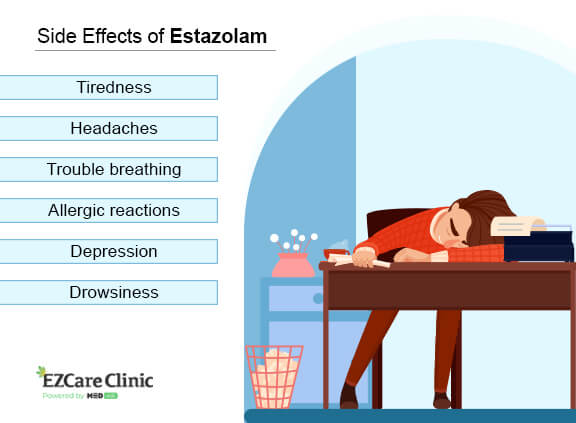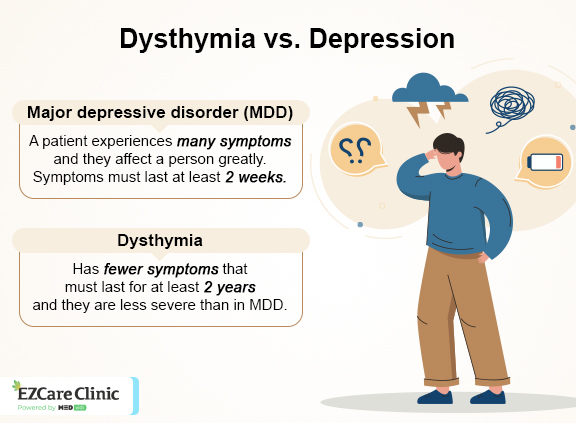The medications listed on this website are provided for informational purposes only. Their inclusion does not guarantee that they will be prescribed to any individual, as treatment decisions are ultimately at the discretion of healthcare providers. This list is not exhaustive, and healthcare providers may prescribe other medications, including non-stimulant options, based on the patient's unique health circumstances and needs.
When someone is gloomy, bleak, or having feelings of emptiness, they might just need to get support from their loved ones or have a rest. However, if such feelings are persistent, continued, and are accompanied by changes in their weight and sleeping patterns, they may have depression or dysthymia.
Depression is a medical disorder that affects a person’s mood and thoughts. There are various types of depression, and even though they have similar symptoms, their effects may be different. It is, therefore, crucial to know more about depressive disorders to better understand your state and get proper treatment. In this post, let’s review the characteristics of one mild type—dysthymia.
Long-term symptoms of depression can be a sign of dysthymia. Get your mental health examined by a professional.
What Is Dysthymia?
The International Classification of Diseases (ICD) and the Diagnostic and Statistical Manual for Mental disorder define dysthymia (code 300.4, F34.1) as persistent mood affective disorder. Experiencing it, a person loses interest or pleasure in what they used to love or displays a very unhappy (dysphoric) mood that stretches over long periods. In some cases, people with dysthymia may have short episodes of major depression.
Causes of Dysthymia
The exact cause of dysthymia remains unclear. That said,
Additionally, research shows the following possible causes of persistent depressive disorder:
- Genetic predisposition: Dysthymic disorders have a hereditary component; if parents have dysthymia, the odds of their children getting it are also high.
- Stress and trauma: This can result in the onset of depressive episodes, which can eventually lead to dysthymia.
- Social circumstances: Isolation and unavailability of help can perpetuate the chances of getting depressive disorder, especially in old age.
- Underlying psychiatric disorder: If a person has other chronic mental health issues such as anxiety disorders or substance abuse, it can increase the chances of getting dysthymic disorders.
Symptoms of Dysthymia
The symptoms of dysthymia are persistent, lasting for at least 2 years. They may also come and go, presenting themselves at least once every two months.
The symptoms vary depending on the person affected and may include the following:
- Lack of interest in social activities
- Changes in appetite
- Hopelessness
- Episodes of anger and irritability
- Trouble concentrating and making decisions
- Tiredness and lethargy
- Decreased self-esteem
- Sleeping problems

How Is Dysthymia Diagnosed?
At EZCare Clinic, we start with a psychological evaluation. It involves a discussion about your thoughts and feelings, the symptoms you have, their severity, duration, and impact on your daily life or specific spheres. The symptoms will be compared to those mentioned in the DSM-5, and you may also be asked to answer certain diagnostics questionnaires.
In some cases, the doctors suggest patients have blood tests to check for underactive thyroid and other health aspects to exclude the probability of a medical condition causing depression.
Our doctors are ready to evaluate your mental health and recommend proper treatment.
Treatment Options
Dysthymia is a long-term depression and, in severe cases, may even tempt the person to commit suicide. Treating this chronic illness will go a long way in minimizing the chances of contracting major depressive syndrome (MDD).
According to the National Institute of Mental Health statistics, about
Medication Use
Pharmacotherapy is among the preferred methods of dysthymia treatment. The
- Selective serotonin reuptake inhibitors such as Citalopram, Fluoxetine, and Sertraline, among others
- Selective serotonin-norepinephrine reuptake inhibitors such as Desvenlafaxine and Duloxetine
- Tricyclic antidepressants (TCAs), for instance, doxepin
- Noradrenergic agents like nefazodone.
Psychotherapy
Psychotherapy involves talking to a psychologist or psychiatrist to find the best solution to treat chronic depression by working on internal issues and irrational thinking and behavior patterns. Different types of
- Interpersonal psychotherapy: assists patients in dealing with losses or internal disputes.
- Psychodynamic therapy: involves resolving someone’s emotional conflicts from their early childhood.
- Cognitive behavioral therapy: supports patients in getting over self-defeating attitudes by identifying correct thought patterns.
- Manualized group therapy: a therapist counsels several affected people at a time using a specific set of guidelines.

Dysthymia vs Depression
PDD is a consolidation of chronic major depressive disorder and dysthymic disorder per the
| Characteristic | Major Depressive Disorder | Persistent Depressive Disorder |
| Symptoms manifestation | Severe | Mild |
| Diagnostic criteria | At least 5 out of 9 symptoms and additional aspects mentioned in the DSM-5 | At least 2 out of 6 symptoms mentioned in the DSM-5 |
| Episode duration | At least 2 weeks | At least 2 years |
Final Word
Dysthymia is a mild form of long-lasting depression. While there is no known cause of dysthymia, there is ongoing research and tests by scientists seeking to determine the actual cause of the persistent depressive disorder.
Patients may also have to undergo lab tests to rule out other causes of depression and go through a psychological evaluation. The latter is needed because PDD can display symptoms similar to other psychological disorders such as bipolar. A patient may use medication or psychotherapy to treat dysthymia. To get a legit diagnosis and personalized treatment, contact EZCare Clinic today.
Sources
- Persistent depressive disorder
Source link - Dysthymia. (2014)
Source link - Persistent Depressive Disorder. (2023)
Source link - Major Depression
Source link - Dysthymia and Apathy: Diagnosis and Treatment. (2011)
Source link - Dysthymic Disorder. (2009)
Source link - Persistent Depression: Should Such a DSM-5 Diagnostic Category Persist? (2019)
Source link



